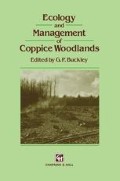Abstract
Almost three-quarters of Britain’s 59 resident butterflies regularly breed in woodland and about one-third are confined to this biotope through a large part of their British range. Most species breed in open woodland habitats such as rides, glades and clearings, where their larvae feed on herbs or grasses growing in the field layer. Relatively few species breed on shrubs and trees (Thomas, 1986;Warren and Fuller, 1990).
Access this chapter
Tax calculation will be finalised at checkout
Purchases are for personal use only
Preview
Unable to display preview. Download preview PDF.
References
Collier, R.V. (1986) The conservation of the chequered skipper in Britain Focus on Nature Conservation, 16, Nature Conservancy Council, Peterborough.
Dempster, J.P. (1989) Insect introductions: natural dispersal and population persist-ence in insects. The Entomologist 108, 5–13.
Dempster, J.P. (1991) Fragmentation, isolation and mobility of insect populations, in The Conservation of Insects and their Habitats (eds N.M. Collins and J.A. Thomas), Symposium of the Royal Entomological Society, No. 15, pp. 143–53, Academic Press, London.
Emmet, A.M. and Heath, J. (1989) The Moths and Butterflies of Great Britain and Ireland Volume 7(1): The butterflies Harley Books, Colchester.
Emmet, A.M., Pyman, G.A. and Corke, D. (1985) The Larger Moths and Butterflies of Essex. Essex Field Club (Passmore Edwards Museum), London.
Forestry Commission (1984) Census of Woodland Trees 1979–82: Great Britain Forestry Commission, Edinburgh.
Forestry Commission (1985) Guidelines for the management of broadleaved woodland Forestry Commission, Edinburgh.
Fuller, R.J. and Warren, M.S. (1990) Coppiced Woodland: its conservation for wildlife Nature Conservancy Council, Peterborough.
Heath, J., Pollard, E. and Thomas, J.A. (1984) Atlas of Butterflies in Britain and Ireland Viking, Middlesex.
Mendel, H. and Piotrowski, S.H. (1986) The Butterflies of Suffolk: An atlas and history Suffolk Naturalists’ Society, Ipswich.
Mitchell, P.L. and Kirby, K.J. (1989) Ecological Effects of Forestry Practices in Long-established Woodland and their Implications for Nature Conservation Oxford Forestry Institute Occasional Paper, 39, Department of Plant Sciences, University of Oxford.
Nature Conservancy Council (1989) Guidelines for the Selection of Biological SSSIs Nature Conservancy Council, Peterborough.
Oates, M.R. and Warren, M.S. (1990) A Review of Butterfly Introductions in Britain and Ireland World Wide Fund for Nature, Godalming.
Peterken, G.F. (1981) Woodland Conservation and Management Chapman and Hall, London.
Pollard, E. (1979) Population ecology and change in range of the white admiral Ladoga camilla in England. Ecological Entomology 4, 61–74.
Pollard, E. (1982) Monitoring butterfly abundance in relation to the management of a nature reserve. Biological Conservation 24, 317–28.
Pollard, E., Hall, M.L. and Bibby, T.J. (1986) Monitoring the abundance of butterflies, 1976–1985. Research and Survey in Nature Conservation, No. 2 Nature Conservancy Council, Peterborough.
Porter, K. (1982) Basking behaviour in larvae of the butterfly Euphydryas aurinia. Oikos 38, 308–12.
Rackham, O. (1980) Ancient Woodland Edward Arnold, London.
Shirt, D.B. (ed.) (1987) British Red Data Books: 2. Insects Nature Conservancy Council, Peterborough.
Southwood, T.R.E. (1977) Habitat, the templet for ecological strategies? Journal of Animal Ecology 46, 337–65.
Thomas, J.A. (1975) Some observations on the early stages of the purple hairstreak butterfly Quercusia quercus (Linnaeus). Entomologist’s Gazette 26, 224–6.
Thomas, J.A. (1984) The conservation of butterflies in temperate countries: past efforts and lessons for the future. Symposium of the Royal Entomological Society of London, 11 Academic Press, London 333–53.
Thomas, J.A. (1986) The RSNC Guide to Butterflies of the British Isles Country Life Books, Twickenham.
Thomas, J.A. and Snazell, R.G. (1989) Declining fritillaries: the next challenge in the conservation of Britain’s butterflies. Annual Report of the Institute of Terrestrial Ecology 1988–89 Cambridge, 54–6.
Thomas, J.A. (1991) Rare species conservation: Case studies of European butterflies, in The Scientific Management of Temperate Communities for Conservation (eds I.F. Spellerburg, F.B. Goldsmith and M.G. Morris), 31st Symposium of the British Ecological Society, Southampton, 1989. Blackwell, Oxford, 149–97.
Warren, M.S. (1984) The biology and status of the wood white butterfly Leptidea sinapis (L.), in the British Isles. Entomologists’s Gazette 35, 207–23.
Warren, M.S. (1985a) The influence of shade on butterfly numbers in woodland rides, with special reference to the wood white Leptidea sinapis. Biological Conservation 33, 147–64.
Warren, M.S. (1985b) The status of the heath fritillary butterfly Mellicta athalia Rott., in relation to changing woodland management in the Blean Woods, Kent. Quarterly Journal of Forestry 79, 174–82.
Warren, M.S. (1987a) The ecology and conservation of the heath fritillary butterfly Mellicta athalia.I. Host selection and phenology. Journal of Applied Ecology 24, 467–82.
Warren, M.S. (1987b) The ecology and conservation of the heath fritillary butterfly Mellicta athalia. II. Adult population structure and mobility. Journal of Applied Ecology 24, 483–98.
Warren, M.S. (1987c) The ecology and conservation of the heath fritillary butterfly Mellicta athalia. III. Population dynamics and the effect of habitat management. Journal of Applied Ecology 24, 499–513.
Warren, M.S. (1991) The successful conservation of an endangered species Mellicta athalia (the heath fritillary butterfly), in Britain. Biological Conservation (in press).
Warren, M.S. and Fuller, R.J. (1990) Woodland Rides and Glades: their management for wildlife Nature Conservancy Council, Peterborough.
Warren, M.S. and Key, R.S. (1991) Woodlands: past, present and potential for insects, in The Conservation of Insects and their Habitats (eds N.M. Collins and J.A. Thomas), Symposium of the Royal Entomological Society, No. 15, Academic Press, London, 155–212.
Warren, M.S., Pollard, E. and Bibby, T.J. (1986) Annual and long-term changes in a population of the wood white butterfly Leptidea sinapis. Journal of Animal Ecology 55, 707–19.
Warren, M.S., Thomas, C.D. and Thomas, J.A. (1984) The status of the heath fritillary butterfly Mellicta athalia Rott., in Britain. Biological Conservation 29, 287–305.
Editor information
Editors and Affiliations
Rights and permissions
Copyright information
© 1992 Springer Science+Business Media Dordrecht
About this chapter
Cite this chapter
Warren, M.S., Thomas, J.A. (1992). Butterfly responses to coppicing. In: Buckley, G.P. (eds) Ecology and Management of Coppice Woodlands. Springer, Dordrecht. https://doi.org/10.1007/978-94-011-2362-4_13
Download citation
DOI: https://doi.org/10.1007/978-94-011-2362-4_13
Publisher Name: Springer, Dordrecht
Print ISBN: 978-94-010-5042-5
Online ISBN: 978-94-011-2362-4
eBook Packages: Springer Book Archive

